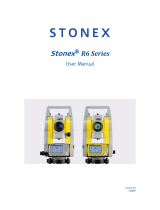
CONTENTS
iv
13. RESECTION MEASUREMENT . . . . . . . . . . . . . . . . . 43
13.1 Coordinate Resection Measurement . . . . . . . . 44
13.2 Height Resection Measurement . . . . . . . . . . . . 47
14. SETTING-OUT MEASUREMENT . . . . . . . . . . . . . . . 51
14.1 Distance Setting-out Measurement . . . . . . . . . 51
14.2 Coordinates Setting-out Measurement . . . . . . . 55
14.3 REM Setting-out Measurement . . . . . . . . . . . . 58
15. SETTING-OUT LINE . . . . . . . . . . . . . . . . . . . . . . . . . 60
15.1 Defining Baseline . . . . . . . . . . . . . . . . . . . . . . . 60
15.2 Setting-out Line Point . . . . . . . . . . . . . . . . . . . . 63
15.3 Setting-out Line Line . . . . . . . . . . . . . . . . . . . . . 64
16. SETTING-OUT ARC. . . . . . . . . . . . . . . . . . . . . . . . . . 67
16.1 Defining an Arc . . . . . . . . . . . . . . . . . . . . . . . . . 67
16.2 Setting-out Arc. . . . . . . . . . . . . . . . . . . . . . . . . . 71
17. POINT PROJECTION . . . . . . . . . . . . . . . . . . . . . . . . 73
17.1 Defining Baseline . . . . . . . . . . . . . . . . . . . . . . . 73
17.2 Point Projection . . . . . . . . . . . . . . . . . . . . . . . . 74
18. OFFSET MEASUREMENT . . . . . . . . . . . . . . . . . . . . 76
18.1 Single-distance Offset Measurement . . . . . . . . 76
18.2 Angle Offset Measurement . . . . . . . . . . . . . . . . 78
18.3 Two-distance Offset Measurement . . . . . . . . . . 80
19. MISSING LINE MEASUREMENT . . . . . . . . . . . . . . . 82
19.1 Measuring the Distance between 2 or more Points . . 82
19.2 Changing the Starting Point . . . . . . . . . . . . . . . 84
20. SURFACE AREA CALCULATION . . . . . . . . . . . . . . 85
21. RECORDING DATA - RECORD MENU - . . . . . . . . . 89
21.1 Recording Instrument Station Data . . . . . . . . . 89
21.2 Recording Backsight Point . . . . . . . . . . . . . . . . 91
21.3 Recording Angle Measurement Data . . . . . . . . 94
21.4 Recording Distance Measurement Data . . . . . . 95
21.5 Recording Coordinate Data . . . . . . . . . . . . . . . 96
21.6 Recording Distance and Coordinate Data . . . . 97
21.7 Recording Notes . . . . . . . . . . . . . . . . . . . . . . . 98
21.8 Reviewing JOB Data . . . . . . . . . . . . . . . . . . . . . 98
22. SELECTING/DELETING A JOB . . . . . . . . . . . . . . . 100
22.1 Selecting a JOB . . . . . . . . . . . . . . . . . . . . . . . 100
22.2 Deleting a JOB . . . . . . . . . . . . . . . . . . . . . . . . 102
MEASURE-
MENT
-MEASURE-
MENT
MODE -





















